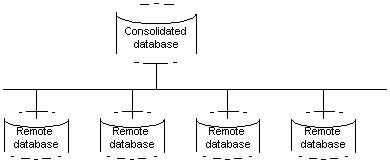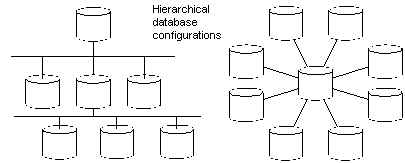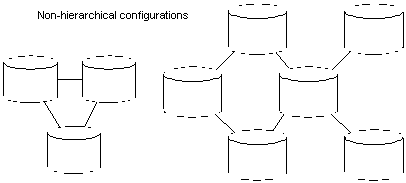 Data Replication with SQL Remote
Data Replication with SQL Remote
 PART 1. Introduction to SQL Remote
PART 1. Introduction to SQL Remote
 CHAPTER 2. SQL Remote Replication Concepts
CHAPTER 2. SQL Remote Replication Concepts
This section introduces concepts and terms used throughout the book.
 Consolidated and remote databases
Consolidated and remote databasesSQL Remote provides data replication between a consolidated database and a set of remote databases.
A consolidated database is a database that contains all the data to be replicated. A remote database is a database that may be running at the same site as the consolidated database or at a physically distant site.
The figure shows a schematic illustration of a small SQL Remote installation.

A replication installation includes many copies of the information in a database. Each copy is a physically separate database on a separate computer. All remote copies must stay consistent with the consolidated database.
The entire replication setup may be considered a single dispersed database, with the master copy of all data being kept at the consolidated database.
Each remote site that submits replications to the consolidated database is considered to be a remote user of the consolidated database. In the case that a remote site is a multi-user server, the entire site is considered to be a single remote user of the consolidated database.
 Hierarchical database configurations
Hierarchical database configurationsSQL Remote supports hierarchical configurations of databases; it does not support peer-to-peer replication or other non-hierarchical configurations.
For any two databases in a hierarchical configuration, one is always above or below the other in the hierarchy.

For databases in a non-hierarchical configuration, there is not any well-defined notion of above or below.

In a SQL Remote installation, each database contains all or a subset of the data replicated by the database above it in the hierarchy.
Remote databases can contain tables that are not present at the consolidated database, as long as they are not involved in replication.
 Two-way replication
Two-way replicationSQL Remote replication is two-way: changes made at the consolidated database are replicated to remote databases, while changes made at remote databases are replicated to the consolidated database, and thence to other remote databases.
 Message-based replication
Message-based replicationSQL Remote exchanges data between databases using messages. This allows replication between databases that have no direct connection: an occasional message-based connection such as e-mail or a periodic dial-up link is sufficient.
In message-based communications, each message carries its destination address and other control information, so that no direct connection is needed between applications exchanging information. For example, an e-mail message contains the destination address; there is no direct connection between the sending server and the recipient.
Just as session-based client/server applications rely on network communication protocol stacks, such as TCP/IP or Novell NetWare's IPX, so message-based applications rely on message services such as Internet Simple Mail Transfer Protocol (SMTP), Microsoft's Messaging API (MAPI), Lotus' Vendor Independent Messaging (VIM), or a simple shared file link.
Message services use store-and-forward methods to get each message to its destination: for example, e-mail systems store messages until the recipient opens their mail folder to read their mail, at which time the e-mail system forwards the message.
Building a replication system on top of a message system means that SQL Remote does not need to implement a store-and-forward system to get messages to their destination. Just as session-based client/server applications do not implement their own protocol stacks to pass information between client and server, so SQL Remote uses existing message systems to pass the messages.

Unlike some session-based communications, many message-based systems do not guarantee that messages reach their destination, or that messages are received in the same order they were sent.
SQL Remote incorporates a protocol to guarantee reception of replication updates in the correct order.
